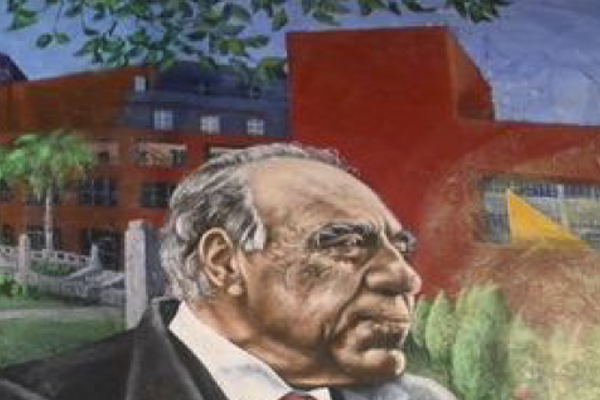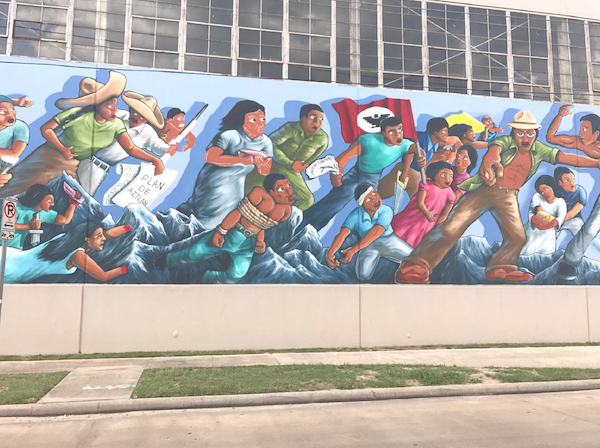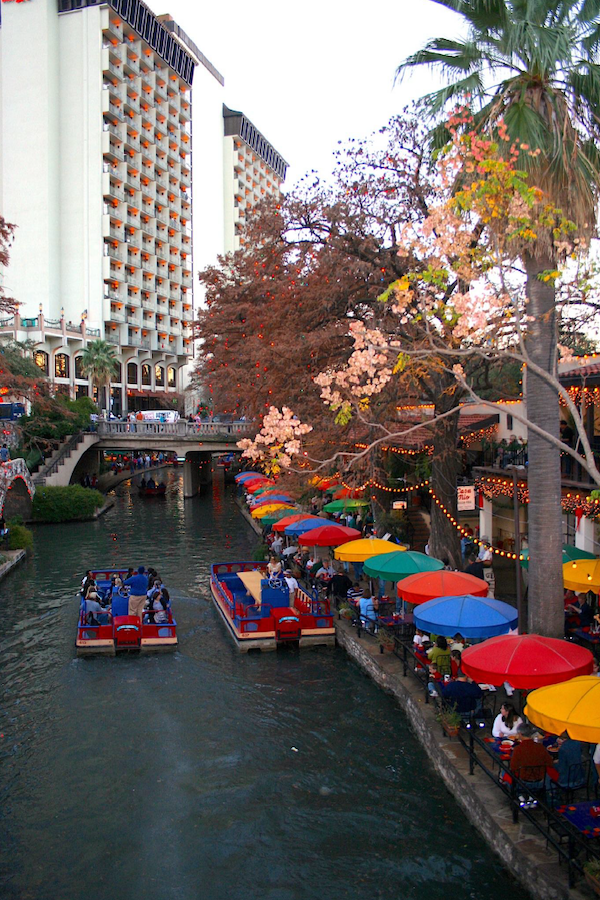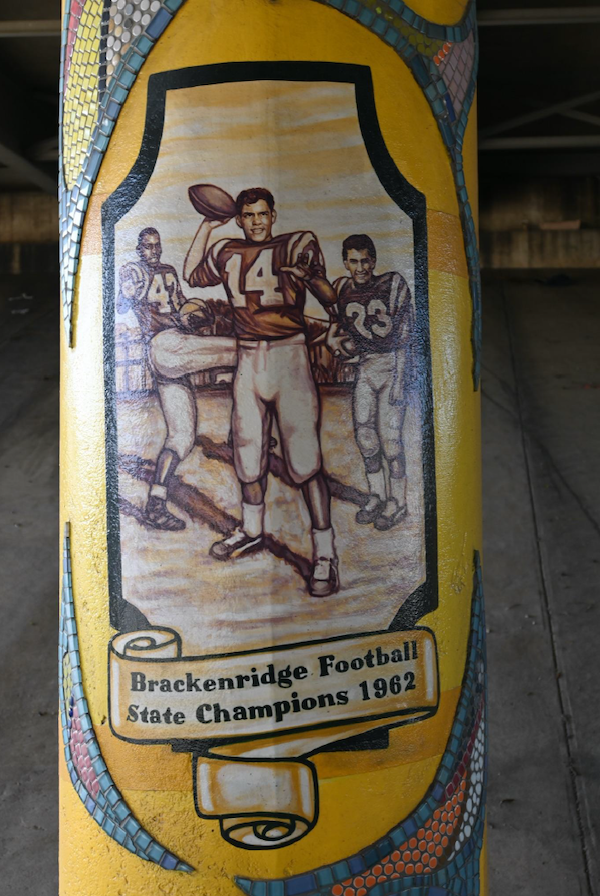Latino Activists Changed San Antonio in the 1960s

Henry B. Gonzalez was elected to Congress from San Antonio's West Side in a 1961 special election, the first Mexican American to represent Texas in the House.
Detail from mural "Mi Teirra" by Robert Ytuarte, photo by author.
In 1960 San Antonio’s Latino population reached 40 percent, and for the first time politicians campaigning for national office paid attention to their vote. The success of the Viva Kennedy Clubs in San Antonio contributed to another pivotal historical moment–the election of one of the first Latinos in Texas to a federally elected post. Among the southern cities, San Antonio also led the way in racial integration, becoming the first Southern city to integrate the city’s schools, libraries, and restaurants. These demographic shifts accounted for representative power in federal posts that generated rapid economic development in San Antonio’s downtown center.
The era also brought unprecedented cultural innovation, racial conflict, and the beginning of a prolonged war in Asia. For young and old, the great rock and roll music of the sixties stands out. The U.S. also witnessed political and social disruptions with the assassinations of John F. Kennedy in 1963, and Robert Kennedy and Martin Luther King in 1968.
The sixties opened with great promise and hope as Americans elected the young, charismatic, first Catholic President John Kennedy. Kennedy campaigned in San Antonio in September of 1960, shortly after selecting U.S. Senator Lyndon Johnson as his running mate. Senator Johnson knew San Antonio well, and his knowledge of local politics represented a boost for the Democratic ticket as well as for the Latino community.
With the exception of New Mexico, a state that had elected several Mexican Americans to the U.S. Congress and the Senate in the 20th century, no other state had sent a Latino to Washington in 100 years. New Mexico had several congressional districts populated largely with Mexican American residents.

The 1960s saw the rise of the various Latino organizations such as the United Farmworkers and Chicano college student movements. Mural by Leo Tanguma and Gonzo. Houston, TX. Photo by Ricardo Romo.
Both Democratic and Republican powers in Texas successfully kept Mexican Americans out of state and national political participation by gerrymandering congressional districts and maintaining the dreaded poll tax which required paying to vote. The poll tax in Texas assured low participation among blue collar workers and proved especially harmful to voter registration drives among low-income Latino families. A special election in 1961 in San Antonio’s 20th Congressional District gave Westside voters the opportunity to elect the first Texas Mexican American ever to the U.S. Congress—Henry B. Gonzalez.
The Mexican American community proved able and ready for this opportunity. In the fall of 1961, San Antonians gathered at Las Palmas Shopping Center in the Westside to hear Vice President Lyndon Johnson’s endorsement of Texas State Senator Henry B.Gonzalez. This campaign helped usher in significant political change for San Antonio. With the help of Vice President Lyndon Johnson, Henry B. Gonzalez won the 20th U.S. Congressional seat. The newly elected Mexican American congressman went to Washington in 1961 with federal connections and significant local support.
Back home, San Antonians witnessed cultural change expressed in rock and roll music, as well as the advent of feminism, youthful defiance to the “establishment,” and the gradual collapse of segregation.
How San Antonians handled this new era of greater inclusion says much about the role of progressive city leaders and reasonable policy strategies. San Antonio had been among the first Southern cities to fully integrate the local schools following the Supreme Court Brown vs. Board of Education decision in 1954 prohibiting segregation.
By the fall of 1960, newspaper stories of Black athletes excelling in football, track, and basketball in San Antonio’s formerly all white high schools were commonplace. Still, however, these Black high school students could only sit in the “colored” section of the major movie theaters downtown. In the early sixties I witnessed small demonstrations of Black students from my own high school, Fox Tech, marching in front of the Aztec Theater protesting the segregated seating policy.
The early months of 1960 also saw major development in the city’s civil rights posture. Old traditions were withering, and young Black students impatient with the progress of change took the lead to challenge segregation. Across America, Black college students led the way in developing new strategies of resistance and confrontation in the civil rights movement. The anti-racists' new strategies gained national attention when four North Carolina college students staged a “sit in” at a “whites only” lunch counter in the Greensboro, North Carolina Woolworth store. The students were beaten and arrested.
San Antonio became one of the many southern cities tested that spring by Black student activists. The local quest to end segregation came on March 16,1960 when Blacks entered the Woolworth department store downtown where lunch counters had long been reserved for white patrons only. Blacks patrons were allowed to shop, but not to eat at the lunch counters. In the previous weeks, Mary Andrews, a student at Our Lady of the Lake University on the Westside, had taken on the task of requesting six stores to end their segregated practices.
San Antonio Latino political leaders stepped up to ease any potential racial tension. City attorney Carlos Cadena instructed the police not to arrest students engaged in peaceful demonstrations. When the stores opened their lunch counters to Blacks the next day, San Antonio became the first city in the South to peacefully integrate public eating establishments.
San Antonians participated in a political revolution and social transformation and set an example for the rest of America. However, the right to sit at lunch counters at local department stores was only a small victory in a long battle that soon shifted to challenging discrimination in voting rights, housing, and employment. With the passage of the 1964 Civil Rights Act signed by President Lyndon B. Johnson, segregation was declared illegal. Local Black leaders also praised the passage of the 1965 Voting Rights Act which expanded the rights of Black voters.
San Antonio’s Hemisfair 68 ushered a new era in San Antonio. Downtown had been popular with U.S.
servicemen, but few tourists went there. Tourists preferred visiting the local historic missions and the Alamo. With the opening of Hemisfair, restaurants and jazz clubs clustered along the Riverwalk, and large new hotel chains opened in the downtown center. The city earned a new nickname, River City, as the city expanded the San Antonio Riverwalk.

The San Antonio Riverwalk is now one of the most visited tourist spots in Texas. Photo by Ricardo Romo
Hemisfair 68 succeeded because of earlier resolutions ending the political exclusion of Mexican Americans. The end of segregated public facilities that had kept Blacks from enjoying the downtown businesses and cultural events opened the community to all residents. Congressman Gonzalez stepped up using his political connections to secure federal funds to bring Hemisfair 68 to San Antonio.These early victories remain important because they made San Antonio a model city that avoided racial strife and supported progress in civil rights at a steady pace.
The 1960s represented a transformative era for San Antonio. The city’s progressive response to racial integration helped win additional support for federal funds, including the expansion of five military bases. Several Latinos won local political posts, including Albert Pena who won a seat on the powerful Bexar County Commisioner’s Court. The city also celebrated the Brackenridge football team that won a State football championship in 1962 with Black, Latino, and Anglo players–another first for Texas football and perhaps for the entire South.

Led by Latino quarterback Victor Castillo [14] and sensational running back Warren McVea [42], Brackenridge High School was the first high school in the South to win a State Championship with an integrated football team.
The influence of progressive Latino leaders has continued to make San Antonio a focal point for Latino culture, inclusiveness, and fair political representation.